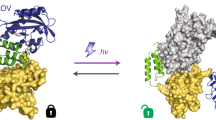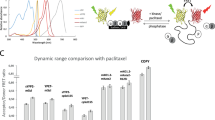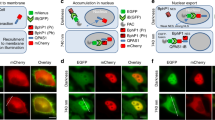Abstract
The precise spatio-temporal dynamics of protein activity are often critical in determining cell behaviour, yet for most proteins they remain poorly understood; it remains difficult to manipulate protein activity at precise times and places within living cells. Protein activity has been controlled by light, through protein derivatization with photocleavable moieties1 or using photoreactive small-molecule ligands2. However, this requires use of toxic ultraviolet wavelengths, activation is irreversible, and/or cell loading is accomplished via disruption of the cell membrane (for example, through microinjection). Here we have developed a new approach to produce genetically encoded photoactivatable derivatives of Rac1, a key GTPase regulating actin cytoskeletal dynamics in metazoan cells3,4. Rac1 mutants were fused to the photoreactive LOV (light oxygen voltage) domain from phototropin5,6, sterically blocking Rac1 interactions until irradiation unwound a helix linking LOV to Rac1. Photoactivatable Rac1 (PA-Rac1) could be reversibly and repeatedly activated using 458- or 473-nm light to generate precisely localized cell protrusions and ruffling. Localized Rac activation or inactivation was sufficient to produce cell motility and control the direction of cell movement. Myosin was involved in Rac control of directionality but not in Rac-induced protrusion, whereas PAK was required for Rac-induced protrusion. PA-Rac1 was used to elucidate Rac regulation of RhoA in cell motility. Rac and Rho coordinate cytoskeletal behaviours with seconds and submicrometre precision7,8. Their mutual regulation remains controversial9, with data indicating that Rac inhibits and/or activates Rho10,11. Rac was shown to inhibit RhoA in mouse embryonic fibroblasts, with inhibition modulated at protrusions and ruffles. A PA-Rac crystal structure and modelling revealed LOV–Rac interactions that will facilitate extension of this photoactivation approach to other proteins.
This is a preview of subscription content, access via your institution
Access options
Subscribe to this journal
Receive 51 print issues and online access
$199.00 per year
only $3.90 per issue
Buy this article
- Purchase on Springer Link
- Instant access to full article PDF
Prices may be subject to local taxes which are calculated during checkout




Similar content being viewed by others
References
Goeldner, M. & Givens, R. Dynamic Studies in Biology: Phototriggers, Photoswitches and Caged Biomolecules (Wiley-VCH, 2005)
Fortin, D. L. et al. Photochemical control of endogenous ion channels and cellular excitability. Nature Methods 5, 331–338 (2008)
Raftopoulou, M. & Hall, A. Cell migration: Rho GTPases lead the way. Dev. Biol. 265, 23–32 (2004)
Ridley, A. J. et al. Cell migration: integrating signals from front to back. Science 302, 1704–1709 (2003)
Christie, J. M., Salomon, M., Nozue, K., Wada, M. & Briggs, W. R. LOV (light, oxygen, or voltage) domains of the blue-light photoreceptor phototropin (nph1): binding sites for the chromophore flavin mononucleotide. Proc. Natl Acad. Sci. USA 96, 8779–8783 (1999)
Harper, S. M., Neil, L. C. & Gardner, K. H. Structural basis of a phototropin light switch. Science 301, 1541–1544 (2003)
Kraynov, V. S. et al. Localized Rac activation dynamics visualized in living cells. Science 290, 333–337 (2000)
Pertz, O., Hodgson, L., Klemke, R. L. & Hahn, K. M. Spatiotemporal dynamics of RhoA activity in migrating cells. Nature 440, 1069–1072 (2006)
Burridge, K. & Wennerberg, K. Rho and Rac take center stage. Cell 116, 167–179 (2004)
Ridley, A. J., Paterson, H. F., Johnston, C. L., Diekmann, D. & Hall, A. The small GTP-binding protein rac regulates growth factor-induced membrane ruffling. Cell 70, 401–410 (1992)
Sander, E. E., ten Klooster, J. P., van Delft, S., van der Kammen, R. A. & Collard, J. G. Rac downregulates Rho activity: reciprocal balance between both GTPases determines cellular morphology and migratory behavior. J. Cell Biol. 147, 1009–1022 (1999)
Yao, X., Rosen, M. K. & Gardner, K. H. Estimation of the available free energy in a LOV2-Jα photoswitch. Nature Chem. Biol. 4, 491–497 (2008)
Salomon, M., Christie, J. M., Knieb, E., Lempert, U. & Briggs, W. R. Photochemical and mutational analysis of the FMN-binding domains of the plant blue light receptor, phototropin. Biochemistry 39, 9401–9410 (2000)
Harper, S. M., Christie, J. M. & Gardner, K. H. Disruption of the LOV-Jα helix interaction activates phototropin kinase activity. Biochemistry 43, 16184–16192 (2004)
Thompson, G., Owen, D., Chalk, P. A. & Lowe, P. N. Delineation of the Cdc42/Rac-binding domain of p21-activated kinase. Biochemistry 37, 7885–7891 (1998)
Patterson, G. H. & Lippincott-Schwartz, J. A photoactivatable GFP for selective photolabeling of proteins and cells. Science 297, 1873–1877 (2002)
Vicente-Manzanares, M., Zareno, J., Whitmore, L., Choi, C. K. & Horwitz, A. F. Regulation of protrusion, adhesion dynamics, and polarity by myosins IIA and IIB in migrating cells. J. Cell Biol. 176, 573 (2007)
Burridge, K. & Chrzanowska-Wodnicka, M. Focal adhesions, contractility, and signaling. Annu. Rev. Cell Dev. Biol. 12, 463–518 (1996)
Giannone, G. et al. Lamellipodial actin mechanically links myosin activity with adhesion-site formation. Cell 128, 561–575 (2007)
Davies, S. P., Reddy, H., Caivano, M. & Cohen, P. Specificity and mechanism of action of some commonly used protein kinase inhibitors. Biochem. J. 351, 95–105 (2000)
Kurokawa, K. & Matsuda, M. Localized RhoA activation as a requirement for the induction of membrane ruffling. Mol. Biol. Cell 16, 4294–4303 (2005)
Rohl, C. A., Strauss, C. E., Misura, K. M. & Baker, D. Protein structure prediction using Rosetta. Methods Enzymol. 383, 66–93 (2004)
Halavaty, A. S. & Moffat, K. N- and C-terminal flanking regions modulate light-induced signal transduction in the LOV2 domain of the blue light sensor phototropin 1 from Avena sativa. Biochemistry 46, 14001–14009 (2007)
Nobes, C. D. & Hall, A. Rho, rac, and cdc42 GTPases regulate the assembly of multimolecular focal complexes associated with actin stress fibers, lamellipodia, and filopodia. Cell 81, 53–62 (1995)
Lee, J. et al. Surface sites for engineering allosteric control in proteins. Science 322, 438–442 (2008)
Moglich, A., Ayers, R. A. & Moffat, K. Design and Signaling Mechanism of Light-Regulated Histidine Kinases. J. Mol. Biol. 385, 1433–1444 (2008)
Strickland, D., Moffat, K. & Sosnick, T. R. Light-activated DNA binding in a designed allosteric protein. Proc. Natl Acad. Sci. USA 105, 10709–10714 (2008)
Leung, D. W., Otomo, C., Chory, J. & Rosen, M. K. Genetically encoded photoswitching of actin assembly through the Cdc42-WASP-Arp2/3 complex pathway. Proc. Natl Acad. Sci. USA 105, 12797–12802 (2008)
Hodgson, L., Shen, F. & Hahn, K. M. Biosensors for characterizing the dynamics of Rho family GTPases in living cells. Curr. Protoc. Cell Biol. (in the press)
Acknowledgements
We are grateful for help and constructs from W. Briggs, K. Moffat, A. Tripathy, G. Bokoch and K. Jacobson. Diffraction data were collected at the Swiss Light Source, beamline X10SA, Paul Scherrer Institute, Villigen, Switzerland. We thank the Dortmund-Heidelberg team for data collection, and A. Pauluhn and M. Fuchs for their support in setting up the beamline. This research was supported by the American Heart Association (Y.I.W.) and the National Institutes of Health (K.M.H. grants GM057464 and GM64346).
Author Contributions Y.I.W. initiated the project, demonstrated the validity of caging Rac with LOV, and performed the studies of Rac biological function. He was assisted by A.J. in cloning and protein expression. D.F. and I.S. determined and analysed the crystal structures. O.I.L. performed molecular modelling and isothermal calorimetry studies under the direction of B.K. K.M.H. coordinated the study and wrote the final version of the manuscript, based on contributions from all authors.
Author information
Authors and Affiliations
Corresponding authors
Supplementary information
Supplementary Information
This file contains Supplementary Notes, Supplementary Figures S1-S14 with Legends, Supplementary Tables S1-S5, Legends for Supplementary Movies S1-S16 and Supplementary References. (PDF 1507 kb)
Supplementary Movie S1
This movie file shows ruffles and protrusions induced in a HeLa cell expressing PA-Rac1 - see file s1 for full Legend. (MOV 5158 kb)
Supplementary Movie S2
This movie file shows localized illumination of PA-Rac1 - see file s1 for full Legend. (MOV 4219 kb)
Supplementary Movie S3
This movie file shows actin reorganization induced by sequential activation of PA-Rac1 at multiple locations - see file s1 for full Legend. (MOV 5105 kb)
Supplementary Movie S4
This movie file shows translocation of PAK to protrusions upon PA-Rac1 activation - see file s1 for full Legend. (MOV 3337 kb)
Supplementary Movie S5
This movie file shows reversible induction of ruffling at different locations - see file s1 for full Legend. (MOV 9874 kb)
Supplementary Movie S6
This movie file shows complex control of cell morphology guided by a moving laser beam - see file s1 for full Legend. (MOV 12170 kb)
Supplementary Movie S7
This movie file shows diffusion of PA-Rac1 observed using FRAP (fluorescence recovery after photobleaching) - see file s1 for full Legend. (MOV 6159 kb)
Supplementary Movie S8
This movie file shows diffusion of PA-Rac1 observed using PA-GFP - see file s1 for full Legend. (MOV 3954 kb)
Supplementary Movie S9
This movie file shows polarization induced by localized activation of PA-Rac1 – see file s1 for full Legend. (MOV 975 kb)
Supplementary Movie S10
This movie file shows that localized irradiation of PA-Rac1-T17N generates reversed polarity – see file s1 for full Legend. (MOV 1057 kb)
Supplementary Movie S11
This movie file shows that irradiation of PA-Rac1-T17N reverses polarization – see file s1 for full Legend. (MOV 1685 kb)
Supplementary Movie S12
This movie file shows directional migration induced by repeated irradiation at the cell edge – see file s1 for full Legend. (MOV 14014 kb)
Supplementary Movie S13
This movie file shows directional migration induced by PA-Rac1 in HEK293 cells – see file s1 for full Legend. (MOV 10906 kb)
Supplementary Movie S14
This movie file shows downregulation of RhoA activity propagates from the site of PA-Rac1 activation - see file s1 for full Legend. (MOV 3611 kb)
Supplementary Movie S15
This movie file shows ruffle translocation upon activation of PA-Rac1 - see file s1 for full Legend. (MOV 3844 kb)
Supplementary Movie S16
This movie file shows contrasting morphological changes produced by activation of PACdc42 versus PA-Rac1– see file s1 for full Legend. (MOV 4226 kb)
Supplementary Data 1
This zipped file contains the data for PA-RAC1(C450A). (ZIP 62 kb)
Supplementary Data 2
This zipped file contains the data for PA-RAC1(C450M). (ZIP 59 kb)
Supplementary Data 3
This zipped file contains the data for PA-RAC1(WT). (ZIP 58 kb)
Rights and permissions
About this article
Cite this article
Wu, Y., Frey, D., Lungu, O. et al. A genetically encoded photoactivatable Rac controls the motility of living cells. Nature 461, 104–108 (2009). https://doi.org/10.1038/nature08241
Received:
Accepted:
Published:
Issue Date:
DOI: https://doi.org/10.1038/nature08241
This article is cited by
-
The cytoskeleton adaptor protein Sorbs1 controls the development of lymphatic and venous vessels in zebrafish
BMC Biology (2024)
-
Development of an optogenetics tool, Opto-RANK, for control of osteoclast differentiation using blue light
Scientific Reports (2024)
-
Cells play tug-of-war to start moving collectively
Nature Physics (2024)
-
Spontaneous rotations in epithelia as an interplay between cell polarity and boundaries
Nature Physics (2024)
-
A general method for chemogenetic control of peptide function
Nature Methods (2023)
Comments
By submitting a comment you agree to abide by our Terms and Community Guidelines. If you find something abusive or that does not comply with our terms or guidelines please flag it as inappropriate.



